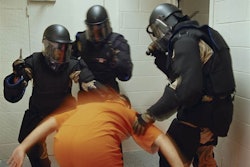 Law enforcement officers are ethically and legally obligated to handle a mentally disturbed person in an empathetic, humane manner.POLICE
Law enforcement officers are ethically and legally obligated to handle a mentally disturbed person in an empathetic, humane manner.POLICE
Law enforcement officers are ethically and legally obligated to handle a mentally disturbed person in an empathetic, humane manner. For most police professionals, gone are the bad old days when one might have referred to a disturbed person as a wacko, lunatic, or nut case. Indeed, most peace officers have come to realize the importance of treating a seriously troubled soul in the same manner in which he or she would want to be treated if the tables were turned. But thoughtful, caring handling of an EDP does not mean that valid officer safety practices should be relaxed for even a moment. Tragically, it is possible to cite more than a few examples in which peace officers have paid with their lives for their unwitting or unwary handling of an EDP.
A deputy was killed after responding to a disturbance involving a former mental patient. The officer ended up struggling with the man outside the residence and subsequently received fatal injuries from being struck in the head with a clothes iron.
The chief of a small city police department went to the home of an elderly male who was known to have a history of mental illness. The man had called for the chief to come look at his furniture, which he alleged someone had been moving around to annoy him. The chief exited his car and had advanced just a few feet when he was hit fatally in the chest with a bullet from a .38-caliber handgun. The murderer then committed suicide.
A patrolman was killed by an EDP while on a traffic stop. The officer and his partner were handling a vehicle contact when an uninvolved male adult approached and began ranting about drug agents. When the officer got out of the patrol car to contact the highly agitated man, he was shot in the head with a handgun.
There can be no doubt that handling an emotionally disturbed person is a potentially high-risk assignment. Fortunately, there are a number of common sense precautions you can take to prevent you from ending up like the officers in the preceding, real-life scenarios.
Gather As Much Information as Possible
Your own safety as well as the welfare of the subject you are dealing with can depend upon your learning as much as you can about the situation in the time you have available. Gather as much information as you can before and during your EDP contact. Ask questions of anyone present, such as family members, associates, and witnesses to the behavior that brought you to the scene.
What was the subject doing to attract attention? After all, it is not against the law simply to act in an odd manner. Do the subject's actions clearly show that he represents a danger to himself or others? Call upon your own careful observations as you reach a decision on whether or not the person must be taken into protective custody. What has he said or done in your presence? Is he clearly acting in a threatening manner? Once more, recall that it is not against the law to be "different." It is one thing if the middle-aged housewife you are talking with suspects that there are green aliens living in her attic. It is quite another if she announces her intention to torch the place to drive them out.
Almost every jurisdiction has local "characters" known for acting in a bizarre fashion, perhaps for years. These folks may continue their antics for a lifetime with no harm to anyone. But realize that the town "character" may one day, without warning, climb the local water tower and begin sniping everyone below. There's generally no way of knowing in advance which "character" will become a killer. Also remember that you may unexpectedly encounter an EDP on another kind of call or contact. EDPs have engaged officers in high-speed pursuits and robbed banks.
Signs of Emotionally Disturbed Persons
It's worth saying again: Being very upset and being "different" are not crimes. It is only when an individual is acting out to the extent that he or she poses a threat to themselves or others that your intervention as a first responder might be needed. Signs of a very emotionally disturbed person may include the following:
- The individual is very disoriented (unsure as to identity, date, location, time of day).
- The person is delusional ("I'm the President of the United States," "You are Satan," etc.).
- The subject is hallucinating; sees things or persons that are not present or hears things that no one else can hear.
- The person is extremely agitated or emotional, perhaps laughing or crying hysterically, for no readily apparent reason.
- The individual repeatedly screams, howls, growls, or spouts unintelligible gibberish.
- The person engages in seemingly endless repetitive motions, such as rocking back and forth.
- The individual inexplicably acts out in a very aggressive or violent manner, such as smashing property or assaulting others.
- The person verbally threatens to harm himself or others (suicidal or homicidal).
None of these things, taken alone, serves as an ironclad indicator that an individual displaying such behavior must be taken into protective custody as an EDP. But all indicate the need for further inquiry.
Consider Other Possibilities for the Behaviour
Realize that there may be explanations beyond serious mental illness for an individual's apparently inexplicable behavior, including some of the behaviors described above. Alcohol or drug intoxication can produce similar effects. Is there physical evidence of the ingestion of alcohol or medications, legal or otherwise? Some illnesses and conditions can produce hallucinations and other strange symptoms. Head injuries can do the same. So can a very high body temperature.
If you have any doubt about what is going on with your subject, summon emergency medical assistance without delay. A life could well hang in the balance. Continue to gather information and analyze the data you gather. Get professional advice promptly. At the same time, do not relax your officer safety vigilance. Some very ill people have committed some pretty awful crimes.
Always Have Help, Never Go Solo
Dealing with an EDP is not a job you should ever handle solo. It is well-documented that emotionally disturbed individuals can display seemingly superhuman strength. They also can appear oblivious to pain, thereby neutralizing the effect of a normally effective pain compliance hold or defensive chemical spray.
It is not a bad idea to have paramedics staged and standing by from the moment you begin dealing with an EDP. You may need them quickly if violence erupts or an EDP begins exhibiting signs of physical or emotional distress.
Having sufficient help on hand, whether that means one partner or three, can make all the difference if force must be used to take a combative EDP into protective custody. An extra set of muscles (or several) can make it much less likely that anyone, including you, receives significant injury in the process.
Do not skimp on summoning as much aid as you think you will need. In one infamous case from the South a few years ago, an adult male EDP disarmed and killed two officers who were attempting to wrestle him into custody. Keep sufficient help with you during transport and processing of your EDP.
There are a number of less-lethal alternatives available today to help you in handling a violent EDP without killing or seriously injuring him. They range from chemical sprays, to bean bags, to propelled nets, to electronic control weapons. All, of course, require adequate training to be effective. Try to have one or more of these alternatives on hand for an EDP encounter. But remember that an officer deploying a less-lethal device must be backed up by a cover officer with deadly force capability just in case the first option fails and officers' lives are at serious risk.
Follow Standard Officer Safety Guidelines
Your primary concern while dealing with an EDP is assuring your own safety as well as that of the subject and any others who may be present, including your partner(s). Meanwhile, do not overlook your own survival needs. Bring all of your officer safety training to bear in dealing with an EDP.
Do not telegraph your arrival. Don't knock on a door while standing directly in front of it. Keep a good distance (reactionary gap) of several feet between yourself and the person you are handling. Do not get too close too soon.
Stay alert for a surprise attack. An EDP may change without warning from a sobbing, compliant individual to a violent attacker who is going for your throat or your gun. Follow flawless weapon retention practices. Be conscious of the location of your weapons, including the less lethal ones, and keep them covered and turned away from the EDP.
Have some contingency plans, including an escape route, and be prepared to back off temporarily if the odds are clearly stacked against you. If your subject is responding to your presence in a bizarre or threatening manner, consider keeping a physical barrier such as a piece of furniture or your car's hood between you and him.
Do not get in so much of a hurry that you miss key danger signs, such as the fact that a subject's behavior is escalating. Watch his hands carefully. Watch your back. Stay beyond his quick reach.
If you must take an EDP into protective custody, follow careful prisoner-handling techniques. Make sure he is both off-balance and under the watchful eye of a cover officer. Follow solid contact and cover tactics. Always properly handcuff and search an EDP you take into custody.
This cardinal rule remains true whether your subject is charged with a crime or seized on a protective, "civil" hold. Remove from the subject's person anything with which he could hurt you or himself. That includes belts, ties, shoelaces, ballpoint pens, and other sharp or pointed objects.
Shun "cowboy" tactics and keep your own safety as well as that of the EDP foremost in your mind. Take all the time you need. Being out of service for an extended period is preferable to getting into a violent struggle if that struggle can be avoided.
Use Calming Techniques to Prevent Escalation
Responding to an emotionally disturbed person in a calm manner could prevent a situation from escalating into a problem. Do not make an EDP feel you are crowding him. Suddenly laying hands on an extremely agitated person may only make things much worse. Try to avoid loud noises, the display of weapons (unless the subject is menacing you or someone else, of course) or other surprises.
Tell the truth. Going along with an emotionally disturbed person's hallucinations, such as by agreeing that you can see the little green men, won't help. Do not make promises that you cannot keep. If you know that you are going to handcuff him at some point, do not pledge that you won't.
Talk to the upset person in a tone that is firm and authoritative yet quiet and calm. Do not yell, and do not speak to the individual as if you were talking to a young child. Lowering your voice and speaking slowly may help calm the subject. Repeatedly assure the person that you are there to help and will see to it that he or she comes to no harm.
Practice Patience and Self-Control
A severely disturbed individual may present a supreme test of your patience and tact. He may insult, threaten, and otherwise verbally abuse you in addition to presenting a physical threat. It is absolutely vital that you remain calm, professional, and in control of yourself. It accomplishes nothing good to trade barbed insults with an EDP. Do not make unnecessary threats and don't get into an argument that you cannot hope to win. Continue to speak quietly and be prepared to repeat your questions or instructions, more than once if necessary. Keep your statements simple, clear, and direct.
Do not go into your use-of-force mode unless everything else has failed or appears clearly inappropriate. It is almost always easier to escalate your response, if required, than de-escalate after the fight has started. Stay patient.
Realize that an EDP who is repeatedly goading you may be trying to push you into a "suicide by cop" scenario. Remain in control of yourself as well as the overall scene. Be sure you have adequate help on hand. Be ready to shift your tactics and reach for another tool from your "tool bag" if one approach is not working. That next "tool" may be a less lethal option, such as a defensive spray.
Make Professional Referrals
Your evaluation of what you are dealing with should include determining whether or not the individual must be arrested for a crime he has committed or taken into protective custody for an emergency mental health evaluation. Or your evaluation may tell you that the person's actions and demeanor do not warrant any kind of detention. If your common sense is nagging you that this is really not a person you want to walk away from without taking action, get the advice of a supervisor or mental health specialist. If your agency is fortunate enough to have a crisis intervention team made up of officers with specialized training in handling mentally ill individuals, secure the assistance of one of these specialists.
Every suspected EDP you take into custody should be examined immediately by a medical or mental health professional. A life-threatening illness or injury may be present instead of or in addition to a mental problem. An apparent EDP should never be placed into a lockup or detox facility without first being cleared for incarceration by a competent medical professional. By attending carefully to an EDP's physical as well as mental needs you are protecting his or her life at the same time you guard yourself legally and ethically. Either way, it is the right thing to do.
Safely dealing with all of the issues presented by an emotionally disturbed human being will present one of the most difficult yet potentially most rewarding assignments you will face as a law enforcement officer. Even as you try to help, it is essential that your every action be taken with the safety of yourself, your "client," and the public at large foremost in your mind. Using your well-honed street survival sense can get you safely through a career full of contacts with emotionally disturbed people. It is the only sane thing to do.
Gerald W. Garner, a long-time member of the POLICE Advisory Board, is a division chief for the Lakewood (Colo.) Police Department. A 33-year veteran of law enforcement, he writes and teaches widely on police topics. One of his books, "Surviving the Street" (Charles C. Thomas, 1998), includes a chapter on handling emotionally disturbed persons.















